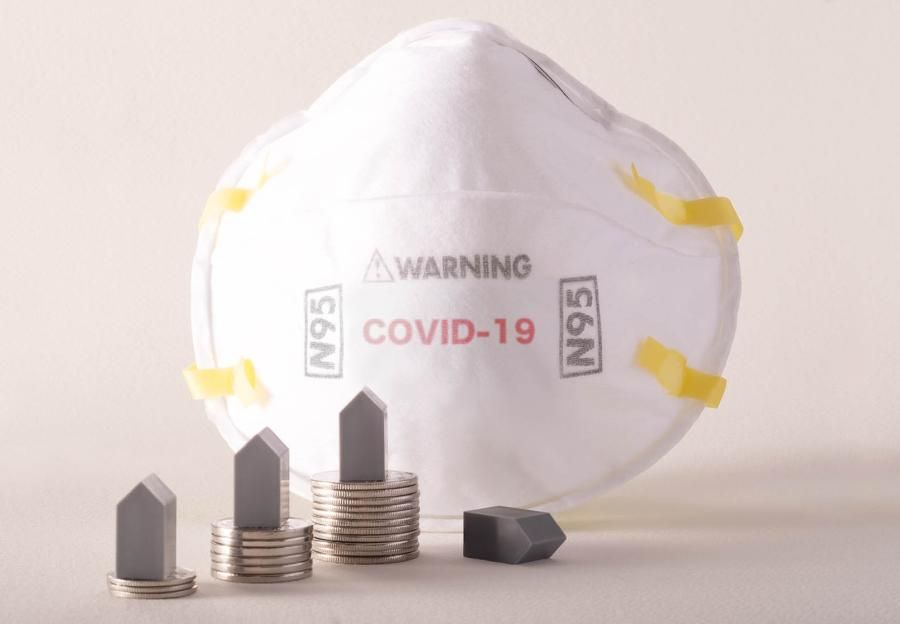A demanding environment for Spain’s real estate sector
Activity in the real estate market is recovering from its extraordinary slump between March and June. House sales and new building permits have regained much of the ground lost in Q3 2020, a trend we expect to consolidate in 2021. House prices, whose trend is still weak but without any extreme corrections, are expected to follow a similar trend in the coming quarters, ending 2021 with a decline of around 2%.

The second wave of the virus is weakening the economic outlook for 2021
Throughout the summer, after the pandemic peaked in March, April and May, the global economy saw a remarkable, widespread recovery in most countries. Nevertheless, the latest indicators point to the second wave of COVID-19 rapidly cooling down this recovery, so we cannot rule out a further decline in activity in Q4 2020. However, it is very important to note that the economic impact of the latest restrictions on people’s movements is clearly less than the effect of the severe lockdown in Q2.
Spain’s economy also recovered strongly in Q3 2020 post-lockdown. Specifically, after decreasing by 17.8% in Q2 2020, Spain’s GDP grew by a significant 16.7% quarter-on-quarter in Q3 2020, confirming the economic recovery despite the fact that it is still 8.7% below its Q3 level last year. However, as has happened in the major international economies, the latest indicators point to this recovery cooling down and a more dubious tone for economic activity in Q4 due to the second wave of COVID infections.
The pandemic is the major determining factor for the economic scenario.
The second wave of the virus has led us to lower our forecasts for 2021, although the recent progress made in health measures provides
a note of optimism.

Not surprisingly, the recent turn of events, worse than anticipated a few months ago, has affected growth prospects. CaixaBank Research’s current scenario predicts 6.0% GDP growth1 in 2021, still a notable recovery but less than previously forecast (8.6%). This scenario is based on a series of hypotheses, including the likelihood that the COVID-19 vaccine will be available in the first few months of the year, in principle for the most vulnerable people, and that other measures will be implemented to diversify the health strategy (such as the mass testing of the population using low-cost, rapid tests), which would support economic activity and ensure a more resilient recovery. However, Spain’s GDP is not expected to reach its pre-crisis levels until 2023, somewhat later than our main European partners given the greater relative weight of tourism in the country’s economy, a sector that will continue to perform well below its potential.
As for the real estate market, activity has also been recovering after going through a slump of unprecedented magnitude during the lockdown. House sales and new building permits have picked up considerably since the summer, a trend we expect to consolidate in 2021. Moreover, the effect of the crisis on house prices has been relatively moderate so far, although we are still expecting some correction in the last few weeks of 2020 and the first half of 2021. Consequently, throughout 2021 the real estate sector will continue to recover gradually from the pandemic’s severe impact.
- 1For further details (in Spanish), see the Nota Breve «Actualización del escenario macroeconómico», available at: https://www.caixabankresearch.com/en/publicaciones/notas-breves-actualidad-economica-y-financiera/espana/actualizacion-del-escenario
Housing demand has regained much of the ground lost but will remain below its potential until the economic recovery has consolidated
Demand for housing has recovered very quickly since the summer. The number of house sales fell only very slightly in September (–1.1% year-on-year), leaving behind the slump observed during the lockdown (–36% year-on-year between March and July). However, there is a significant difference between the sales trends for new and second-hand housing: while sales of new builds have recovered strongly (+29.2% year-on-year), second-hand house sales have continued to decline in year-on-year terms, albeit more slowly than in previous months (–7.4% year-on-year in September compared with –16.1% year-on-year in August). As a result, sales of new builds now account for 22.2% of all house sales, compared with 18.4% in 2019.
One interesting point is the significant rise in sales of houses as opposed to apartments during the pandemic, the historical series reaching a peak in Q3 2020 with 20.4% of all transactions recorded for the quarter.2 This indicates a certain change in consumer preference as people are now looking for larger homes with more outdoor space, such as terraces and gardens, after experiencing months of enforced lockdown due to the health crisis.
Also noteworthy is the strong recovery in house purchases by foreigners3 in Q3 2020 (+42.5% quarter-on-quarter), after the sharp drop in Q2 (–46.6% quarter-on-quarter), bringing the relative share of foreign purchases to 11.4% compared with 10.7% in Q2. In absolute terms, this translates into nearly 11,400 sales to foreigners in Q3 2020 compared with 8,000 in Q2, a figure which, however, is still far from the 15,000+ in Q1 and one year ago. As usual, the British, French, Germans and Belgians are the main buyers of Spanish properties, usually for holiday purposes. These nationalities are followed by the Moroccans and Romanians, who tend to buy housing for residential purposes. The Italians, Swedish, Dutch and Russians complete the top 10 of buyers by nationality.
Although demand for housing has recovered strongly since the lockdown,
the worsening economic situation may again compromise demand over the coming months.
CaixaBank Research forecasts for Spain’s real estate sector

We expect the rate of growth in sales to ease slightly over the next few months. Firstly, because most of the sales that had to be postponed during the lockdown due to mobility restrictions will have now gone through. And, secondly, due to the impact of the economic situation on the gross disposable income of households. Although the labour market has evolved very positively post-lockdown (the Q3 2020 labour force survey (LFS) shows a strong recovery in the total actual hours worked and a 3% increase in employment compared with Q2), recent months have seen a reduction in the reinstatement of furloughed workers from the first wave, with the addition of furloughed workers from the second wave. At CaixaBank Research we therefore expect the unemployment rate to rise significantly in Q1 2021 (to 19%) due to higher job losses in the coming months. However, job creation should gain momentum in Q2 2021, especially in view of the summer, provided our hypothesis is confirmed that the epidemiological situation will allow the tourist season to operate relatively normally.
The factors supporting the rise in demand
(essentially sustained growth in employment, recovery in wages and foreign demand) will remain weak until the epidemiological situation improves.
For their part, financial conditions will continue to support housing demand. Over the coming months, the ECB is very likely to extend some of the monetary policy measures it quickly and forcefully implemented at the start of the pandemic (from asset purchases estimated at almost 2 trillion euros in 2020-2021 and injections of liquidity under very favourable conditions to the easing of regulations and collateral requirements). One reflection of the effectiveness of these measures is the continued improvement in credit to households in order to purchase housing (–6.9% year-on-year in cumulative terms from January to October compared with –37.3% year-on-year between March and May). On the other hand, the Q3 bank lending survey indicates slightly tighter terms and conditions on loans to households for house purchases, although the overall terms and conditions for new loans remain unchanged.4
- 4See «Bank Lending Survey in Spain», Bank of Spain, available at: https://www.bde.es/bde/en/encuesta-sobre-prestamos-bancarios-en-espana--octubre-de-2020-cc951ab49b46571.html
Supply indicators suggest the recovery in the real estate sector is still incomplete
According to national accounting data, construction has been hit hard by the coronavirus crisis and is taking longer to rebound than the economy as a whole. Specifically, the gross value added (GVA) for construction, in real terms, fell by 17.1% in the first half of 2020 while GDP fell by 12.8% over the same period. Although the construction industry’s GVA rose by 22.5% quarter-on-quarter in Q3 2020, it is still 11.0% below the level recorded a year earlier. To put these figures into perspective, however, it should be noted that the GDP of the economy as a whole is 8.7% lower than in Q3 2019. On the other hand, the number of new building permits has fallen significantly, by 23.6% between January and September 2020, although this is a considerable improvement compared with the 37.2% drop recorded in the second quarter. The following chart shows that the number of permits granted up to September 2020 is similar to that of 2017, a year which closed with around 80,000 new building permits, a figure that coincides with our current forecast for new building permits in 2020.
By 2021, we expect the number of new building permits to gradually rise to 90,000. This would bring the production of new housing in line with the net creation of households over the past 12 months (also estimated at 90,000 by the Economically Active Population Survey or EAP). However, it is important to note that the National Statistics Institute (INE) has substantially lowered its projections for net household creation in the next few years. Specifically, the INE forecasts that approximately 60,000 households will be formed per year between 2021 and 2025, less than half the 135,000 households per year projected two years ago. These projections assume considerable flows of foreigners into Spain, taking into account the fact that the number of households made up of Spaniards is expected to fall by around 100,000 per year.
On the other hand, labour market data for the construction industry point to a more positive trend
EPA data show that employment in the construction sector recovered particularly strongly in Q3 2020, with the year-on-year rate rising to 1.6% compared with –8.4% in Q2. However, in effective terms the hours worked provide a better indication of the trend in employment. These figures indicate that, in construction, the actual hours worked in Q3 were already slightly higher than their level a year earlier, up by 0.5%. Moreover, it should be noted that construction workers who had been furloughed have now rejoined the labour market. Whereas these workers accounted for 35.2% of all construction employees in April, by October their percentage had fallen to 3.4%.5 Furlough measures have therefore been a highly effective means of safeguarding jobs during the toughest months of the pandemic.
- 5Average Social Security affiliation figures per month.

House prices are beginning to adjust
So far, the impact of the coronavirus crisis on house prices has been relatively moderate due to their high inertia in changes of cycle. According to the statistics published by the Ministry of Transport, Mobility and Urban Agenda (based on appraisal prices), house prices rose by 0.6% quarter-on-quarter in Q3 2020, interrupting the downward trend of the previous two quarters. In year-on-year terms, the decline in prices slowed down (–1.1% year-on-year versus –1.7% in Q2), while the College of Registrars’ price indicator (based on repeat sales) recorded a 0.2% quarter-on-quarter drop in Q3 2020. Although the year-on-year trend is still positive (0.8%), this indicator shows a marked slowdown compared with the 7.3% year-on-year increase recorded in Q3 2019. INE house prices (based on transaction prices) also slowed down, from 3.2% year-on-year growth in Q1 to 2.1% in Q2, but this indicator has yet to post a decline in quarter-on-quarter terms. INE data suggest that prices for new builds are outperforming those for second-hand housing. Specifically, the price of new housing rose by 4.2% year-on-year in Q2 2020 while the price of second-hand housing rose more moderately by 1.8%.
Another indicator that is particularly relevant in situations of high uncertainty such as the present is the time it takes to sell a property, as this can point to buyers and sellers finding it more difficult to agree on the new equilibrium price for transactions. The various indicators available on real estate portals suggest a slight increase in the time between a property going on sale and the date it is purchased. According to data from the Idealista portal, it took about six months to sell a house in Q3 2020, almost one month more than a year earlier.6
Consequently, in spite of the relatively moderate decline in house prices to date, we still predict a somewhat sharper correction in the latter part of 2020 and first half of 2021. The revival in economic activity expected from spring onwards should support a gradual recovery in house prices in the second half of 2021. However, the far-reaching economic crisis caused by COVID-19 will make this recovery very gradual, so we do not expect prices to return to their pre-crisis levels until 2024.
- 6Idealist study (in Spanish) available at: https://www.idealista.com/news/inmobiliario/vivienda/2020/11/10/ 787808-dime-donde-vives-y-te-dire-cuanto-tardaras-en-vender-tu-casa-ahora
The rental market is the hardest hit
According to the indicators available on various real estate portals, rents have started to come down in most provinces and municipalities in Spain, albeit with a large number of differences across the different markets. One factor that is having a decisive effect on rents in certain areas is the substantial increase in the number of rented flats available, resulting from properties that had originally been intended for short-term tourist rents being transferred to the residential market. According to a study by Fotocasa, 64% of tourist apartment owners have switched to traditional renting.7 There has also been an increase in the average time it takes to rent a property out which, according to a study by Servihabitat,8 is now 58 days, almost 10 days more than one year ago although still far from the 64 days it used to take in 2017.
